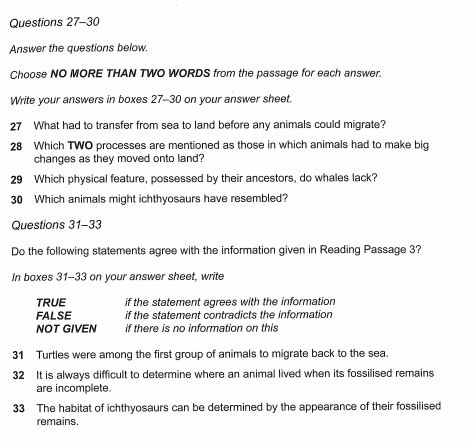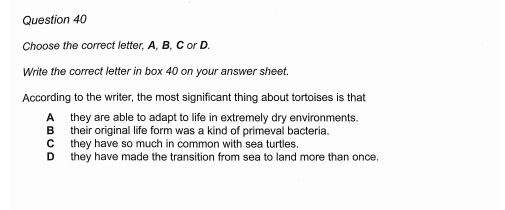剑桥雅思9阅读:Test1雅思阅读PASSAGE3真题+答案+解析
发布时间:2021-04-26 关键词:剑桥雅思9阅读Passage3
The History of the Tortoise
乌龟的进化史
If you go back far enough, everything lived in the sea. At various points in evolutionary history, enterprisingindividuals within many different animal groups moved out onto the land, sometimes even to the most parched deserts, taking their own private seawater with them in blood and cellular fluids. In addition to the reptiles, birds, mammals and insects which we succeeded out or water include scorpions, snails, crustaceans such as woodlice and land crabs, millipedes and centipedes, spiders and various worms. And we mustn't forget the plants, without whose prior invasion of the land none of the other migrations could have happened.
如果追溯到远古时代,那时一切生物都生活在水里。在进化史的不同时期,各个动物种群中都有一些胆大的开始向陆地迁徙,有的甚至跑到了干旱的沙漠里,这些生物的血液与细胞液里还储存着曾经所生活海域里的海水。除了我们周围随处可见的爬行动物、鸟类、哺乳动物和昆虫以外,其他成功登陆的生物还包括蝎子、蜗牛和潮虫、陆蟹、千足虫、蜈蚣等甲壳类动物,还有蜘蛛及各种虫子。当然还有植物,如杲没有它们率先登陆,其他任何生物都不可能在陆地上生存。
Moving from water to land involved a major redesign of every aspect of life, including breathing and reproduction.Nevertheless, a good number of thoroughgoing land animals later turned 1, abandoned their hard-earnedterrestrial re-tooling, and returned to the water again.Seals have only gone part way back. They show us what the intermediates might have been like, on the way to extreme cases such as whales and dugongs. Whales (including the small whales we call dolphins) and dugongs, with their close cousins the manatees, ceased to be land creatures altogether and reverted to the full marine habits of their remote ancestors. They don't even come ashore to breed. They do, however, still breathe air, having never developed anything equivalent to the gills of their earlier marine incarnation. Turtles went back to the sea a very long time ago and, like all vertebrate returnees to the water, they breathe air. However, they are, in one respect, less fully given back to the water than whales or dugongs, for turtles still lay their eggs on beaches.
从水里转移到陆地上使这些生物在方方面面都发生了巨大变化,包括呼吸和繁殖方式。然而,一大批动物彻底在陆地上安家后,却忽然回心转意,放弃了来之不易的陆上新生活,又重新回到了水中。海豹只恢复了部分水中生活的特征,向我们展示了演变过程中半成品的模样,而成品则是如鲸鱼和儒艮这样纯粹的海洋生物。鲸鱼(包括我们称作海豚的小鲸鱼)和儒艮,与它们的同类动物海牛一样不再是陆地动物,而是完全恢复了与老祖先一样的海洋生活习惯,它们甚至都不上岸繁殖。它们虽然仍呼吸空气,却没有进化出类似于鳃这样的早期海洋生物的器官。海龟在很早以前就回到了水中,和其他返回水中的脊椎动物一 样,它们也需要呼吸空气,但是却没有像鲸鱼和儒艮那样完全返回水中,这体现在一个方面——海龟仍然在海滩上产卵。
There is evidence that all modem turtles are descended from a terrestrial ancestor which lived before most of the dinosaurs. There are two key fossils called Proganochelys quenstedti and Paiaeockersis talampayensis dating from early dinosaur times, which appear to be close to the ancestry of all modern turtles and tortoises. You might wonder how we can tell whether fossil animals lived on land or in water, especially if only fragments are found.Sometimes it's obvious. Ichthyosaurs were reptilian contemporaries of the dinosaurs, with fins andstreamlined bodies. The fossils look like dolphins and they surely lived like dolphins, in the water. With turtles it is a little obvious. One way to tell is by measuring the bones of their forelimbs.
有证据表明,所有现代海龟的祖先都曾经生活在陆地上,比大多数恐龙在陆地上出现的时间还要早。有两种可以追溯到恐龙时代早期的重要化石,分别是Proganochelysquenstedti (原颚龟化石)和Potoeocfeersistatompayewsis(古老的陆地龟化石),它们与所有现代海龟和乌龟的祖先最为接近。你可能会问,我们是如何通过动物化石来判断它们是生活在水中还是陆地上的,尤其当我们只找到一些化石碎片的时候。有时候这个问题的答案很明显。鱼龙是与恐龙同时代的爬行动物,它有鱼鳍和流线型的身体。鱼龙化石看起来像海豚,它们确实和海豚一样曾经在水中生活。海龟在这一点上则没有这么明显。判断动物水生还是陆生的方法之一就是对它们前肢的骨骼进行检测。
Walter Joyce and Jacques Gauthier, at Yale University, obtained three measurements in these particular bones of 71 species of living turtles and tortoises. They used a kind of triangular graph paper to plot the three measurements against one another. All the land tortoise species formed a tight cluster of points in the upper part of the triangle; all the water turtles cluster in the lower part of the triangular graph. There was no overlap, except when they added some species that spend time both in water and on land.Sure enough, these amphibious species show up on the triangular graph approximately half way between the 'wetcluster’ of sea turtle and the 'dry cluster* of land tortoises. The next step was to determine where the fossils fell. The bones of P. quenstedti and P.talampayensis leave us in no doubt their points on the graph are right in the thick of the dry cluster. Both these fossils were dry-land tortoises. They come from the era before our turtles returned to the water.
耶鲁大学的Watter Joyce 和 JacquesGauthier 从三个方面对71种活的海龟和乌龟的特有骨骼进行了检测。他们用一种三角坐标纸分别标记了这三个方面的检测结果。所有陆栖乌龟的数据在三角坐标的上半部分形成了一簇密集的点,而所有水栖海龟的数据集中于下半部分。两部分数据没有重叠,除非在其中增加一些水陆两栖乌龟的检测结果。当然,这些数据出现在接近三角坐标中间的位置,位于水栖海龟与陆栖乌龟的坐标点之间。下一步就是确定具体的位置。毫无疑问,P.quenstedti与 P.totompayewsis 的坐标点正好位于陆栖乌龟的坐标点最密集的地方。这两种化石都是陆栖乌龟化石,而且都生存在海龟返回水里之前的时代。
You might think, therefore, that modem land tortoises have probably stayed on land ever since those early terrestrialtimes, as most mammals did after a few of them went back to the sea. But apparently not. If you draw out the family tree of all modem turtles and tortoises, nearly all the branches are aquatic. Today's land tortoises constitute a single branch, deeply nested among branches consisting of aquatic turtles. This suggests that modem land tortoises have not stayed on land continuously since the time of P. quenstedti and P. talampayensis. Rather, their ancestors were among those who went back to the water, and they then re-emerged back onto the land in (relatively) more recent times.
也许你会认为,现代的陆栖乌龟可能自从早期有陆地生物以来就一直生活在陆地上,就像除了少数哺乳动物返回水中以外,大多数哺乳动物还在陆地上生活一样。但事实显然不是这样的。如果你画出所有现代海龟与乌龟的家谱图,会发现几乎所有的龟类分支都属于水栖动物。而现代的陆栖乌龟单独形成一个分支,穿插在水栖海龟的分支中。这说明自P.quenstedti与P. talampayensis的时代以来,现代的陆栖乌龟并没有一直在陆地上生活。更确切地说,它们的祖先曾经返回水中,只是在(相对)较近的年代又回到了陆地上。
Tortoises therefore represent a remarkable double return.In common with all mammals, reptiles and birds, their remote ancestors were marine fish and before that various more or less worm-like creatures stretching back, still in the sea, to the primeval bacteria. Later ancestors lived on land and stayed there for a very large number of generations. Later ancestors still evolved back into the water and became sea turtles. And finally they returned yet again to the land as tortoises, some of which now live in the driest of deserts.
因此很明显,乌龟曾往返于水中和陆地上生存。与所有的哺乳动物、爬行动物和鸟类一样,乌龟的老祖先是海洋中的鱼类。再向前追溯,它们也是海洋中类似蠕虫生物的原始细菌。后来,乌龟的祖先来到陆地 上并持续生活了相当长的年代,但后来又回到了水中,成为了水栖海龟。直到最后,它们再一次回到陆地上,成为陆龟,其中有一些甚至生活在干旱的沙漠中。



Question 27
答案: plants
关键词: before any animals could migrate
定位原文:第1段最后一句话“And we musn’t…”
解题思路: 这句话指出,如果没有植物率先登陆,其他任何生物向陆地的迁徙都不可能完成。这吻合题目中的before any animals could migrate。故答案应该是plants。
Question 28:
答案: breathing and reproduction (in either order)
关键词: TWO processes, make big changes, moved onto land
定位原文:第2段第1句话“Moving from…”
解题思路: 题目问的是:动物要想迁徙到陆地上,必须在哪两个方面作出巨大的改变?此题定位可以根据顺序原则锁定在第二段,而第二段句话就提到Moving from water to land involved a major redesign of every aspect of life, including breathing and reproduction.这句话中的redesign对应题目中的changes。 故答案应该是breathing和reproduction。(并列答案,顺序无关紧要)
Question 29:
答案: gills
关键词: physical feature, whales, lack
定位原文:第2段第5句“Whales (including the small whales we call dolphins) and…”
解题思路:先根据题目关键字定位到whale, 然后通读whale所在的句子,在这段叙述中,作者最后指出虽然鲸鱼仍呼吸空气,却没有进化出类似于鳃这样的早期海洋生物的器官。所以考生可以得出结论,鲸鱼缺乏的其实就是gills。故答案应该是gills。
Question 30:
答案: dolphins
关键词: ichthyosaurs, Resemble
定位原文:第3段倒数第4、3句“Ichthyosaurs were reptilian…”
解题思路: 定位句中的contemporaries是理解重点,指的是“同时代的人,同时代的事物”,这里说明鱼龙年代久远,和恐龙是同时代的动物,但是并不说明鱼龙和恐龙相像(其实也不大可能嘛)。而后半句的look like,就完全呼应题目中 的resemble, 这才是真正答案所在。
故答案应该是dolphins。
Question 31:
答案: NOT GIVEN
关键词: Turtles,the first group
定位原文:第2段倒数第2句“Turtles went back to the sea…” 海龟在很早以前就回到了水中,和其他返回水中的脊椎动物一样,它们也需要呼吸空气。
解题思路:文中在第二段的后半部分次提到了乌龟,这就是本题的定位点。寻找turtle一词后,文中这句话说很久以前,乌龟就重新返回海洋,但是并没有说明是不是批回海洋这个概念。实际上,整篇文章中都没有讨论到关于the first的问题,所以此题属于完全未提及型NOT GIVEN题。
Question 32:
答案: FALSE
关键词: fossilised remains, incomplete, always difficult
定位原文: 第3段第3句“You might…” 你可能会问,我们是如何通过动物化石来判断它们是生活在水中还是陆地上的,尤其当我们只找到一些化石碎片的时候。
解题思路: 在第三段中寻找fossilised一词,很快找到对应词fossil。接着读到fragments,可以对应题目中的incomplete, on land or in water对应题目中的where an animal lived。但题目中的叙述过于,It is always difficult与文中Sometimes it’s obvious明显相抵触。
Question 33:
答案: TRUE
关键词: ichthyosaurs, can be determined by, appearance
定位原文:第3段倒数第4、3句“Ichthyosaurs were reptilian…” 鱼龙是与恐龙同时代的爬行动物,它有鱼鳍和流线型的身体。鱼龙化石看起来像海豚,它们确实和海豚一样曾经在水中生活。
解题思路:通过ichthyosaurs一词确定。文中提到鱼龙的化石看上去像海豚,因此鱼龙肯定生活在海里。这等于举个例子向我们说明只要从鱼龙化石的外表就能够判定它的栖息地,与题目的意思完全吻合。
Question 34:
答案: three measurements
关键词: 71, a total of
定位原文:第4段第1句“...obtained three measurements in these particular…”
解题思路:利用数字71,很快就可以将此题定位。但是要注意在该句中并没有提到题目中的forelimbs。该词出现于上一段的最后一句,在此句中则以these particular bones来指代,要多加注意。如果能够顺利突破这个小障碍,很快就能发现正确答案。正确答案为three measurements。
Question 35:
答案: (triangular) graph
关键词: data, a
定位原文:第4段第2句“They used a kind of triangular graph…”
解题思路:顺着上一题的对应点找下来,可以顺利找到a kind of,这个词组可以等同于题目中的不定冠词a。因此可以初步判定a kind of后面的triangular graph paper可能就是要填写的答案。题目要求NO MORE THAN TWO WORDS,而triangular graph paper有三个词, 只好牺牲最无关紧要的paper。
Question 36:
答案: cluster
关键词: Land tortoises, a dense, points
定位原文:第4段第3句“All the land tortoise species…”
解题思路:题目中需要填的词位于短语a dense of points 中,只要定位到陆龟这个词,再顺着向下读到a tight cluster of points即可。这个词组的结构和题目中的词组一模一样,只是将dense和tight做了替换。正确答案为cluster。
Question 37:
答案: amphibious
关键词: Sea turtles, living, added to
定位原文:第4段第4句“There was no overlap, except when they…”
解题思路: 此题的定位可以根据上一题最后一句话中的sea turtles定位到第四段water turtle后面这句话。从题目可以得知从某种物种搜集的数据被添加到了结果中去。Add一词是解题的关键。读完这句话,很容易发现被添加的物种是既可以在陆上生活,也可以在水中生存的两栖物种。
Question 38:
答案: half way
关键词: up the triangle between
定位原文: 第4段第5句“Sure enough, these amphibious…”
解题思路: 此题十分简单,找到两栖物种之后寻找between,between前面的half way, 就是本题所要的答案。
Question 39:
答案: dry-land tortoises
关键词: P. quenstedti, P. talampayensis, The position of the points, both
定位原文: 第4段倒数第2句“Both these fossils were dry-land tortoises.”
解题思路: 用两个专有名词可以顺利找到第四段结尾处。然后利用题目中的The position of the points锁定在Their points on the graph are right in the thick of the dry cluster.答案就是之后的那句。正确答案为dry-land tortoises 。
Question 40:
答案: D
关键词: the most significant thing, tortoises
定位原文:参见解题思路解析
解题思路: 题目:作者认为关于乌龟最重要的一件事情是:A.它们能够适应极其干燥的环境。B.它们生命的最初形态是某种原始细菌。C.它们与海龟十分相似。D.它们不止一次从海洋迁徙到陆地。最后一段首句就表明Tortoises therefore represent a remarkable double return, 含义为“因此很明显,乌龟曾往返于水中和陆地上生存。”选项A中所说的干燥环境,选项B中所说的原始细菌,以及选项C中提到的海龟,在最后一段中悉数登场,但是没有一个是题目论述的核心。题目的真正意图就是想告诉考生乌龟finally retuned yet again to the land as tortoises。故答案应该选D。




